Page 88 of 308
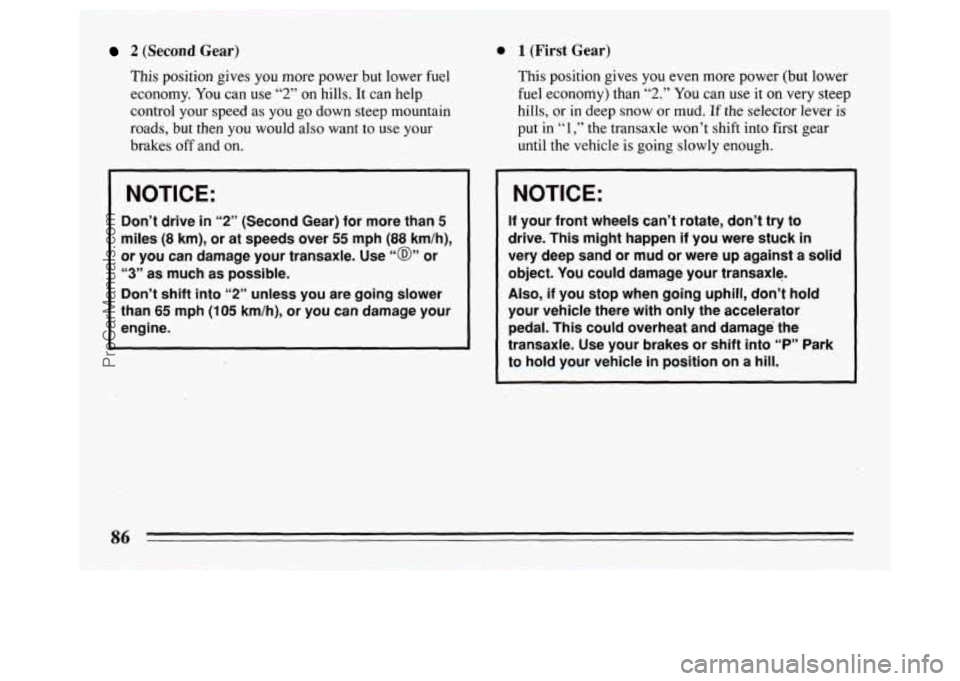
I
I
I
r
2 (Second Gear)
This position gives you more power but lower fuel
economy. You can use
“2” on hills. It can help
control your speed as you go down steep mountain
roads, but then you would also want to
use your
brakes
off and on.
0 1 (First Gear)
This position gives you even more power (but lower
fuel economy) than
“2.” You can use it on very steep
hills, or in deep snow or mud.
If the selector lever is
put in “1,” the transaxle won’t shift into first gear
until the vehicle is going slowly enough.
NOTICE:
Don’t drive in “2” (Second Gear) for more than 5
miles (8 km), or at speeds over 55 mph (88 km/h),
or you can damage your transaxle. Use ‘@” or
“3” as much as possible.
Don’t shift into “2” unless you are going slower
than
65 mph (105 km/h), or you can damage your
engine.
NOTICE:
If your front wheels can’t rotate, don’t try to
drive. This might happen if you were stuck
in
very deep sand or mud or were up against a solid
object. You could damage your transaxle.
Also, if you stop when going uphill, don’t hold
your vehicle there with only the accelerator
pedal. This could overheat and damage the
transaxle. Use your brakes
or shift into “P” Park
to hold your vehicle
in position on a hill.
86
ProCarManuals.com
Page 89 of 308
Parking Brake
To set the parking brake:
Hold the regular brake
pedal
down with your right
foot. Push down
the
paiking brake pedal with yourleft foot.
If the
ignition is on, the brake
system warning light will
come on.
The parking brake uses the brakes on the rear wheels.
To release the parking brake:
This vehicle has a push to release park brake pedal.
Hold
the regular brake pedal down and push the parking
brake pedal with your left foot. This will unlock the
pedal. When you lift your left foot, the park brake pedal
will follow it to the released position.
I NOTICE: 1
Driving with the parking brake on can cause your
rear brakes to overheat. You may have to replace
them, and you could also damage other parts of
your vehicle.
If you are towing a trailer and are parking on any
hill:
See “ Towing a Trailer” in the Index. That section
shows what to do first to keep the trailer from moving.
87
ProCarManuals.com
Page 100 of 308
NOTICE:
When using concentrated washer fluid,
follow the manufacturer’s instructions for
adding water.
0 Don’t mix water with ready-to-use washer
fluid. Water can cause the solution to
freeze and damage your washer fluid tank
and other parts of the washer system.
Also,
water doesn’t clean as well as washer fluid.
Fill your washer fluid tank only 314 full
when it’s very cold. This allows for
expansion, which could damage the tank
if
it is completely full.
windshield washer. It can damage your
washer system and paint.
Don’t use radiator antifreeze in your
Cruise Control (Option)
When you apply your brakes, the Cruise Control shuts
off.
98
ProCarManuals.com
Page 117 of 308
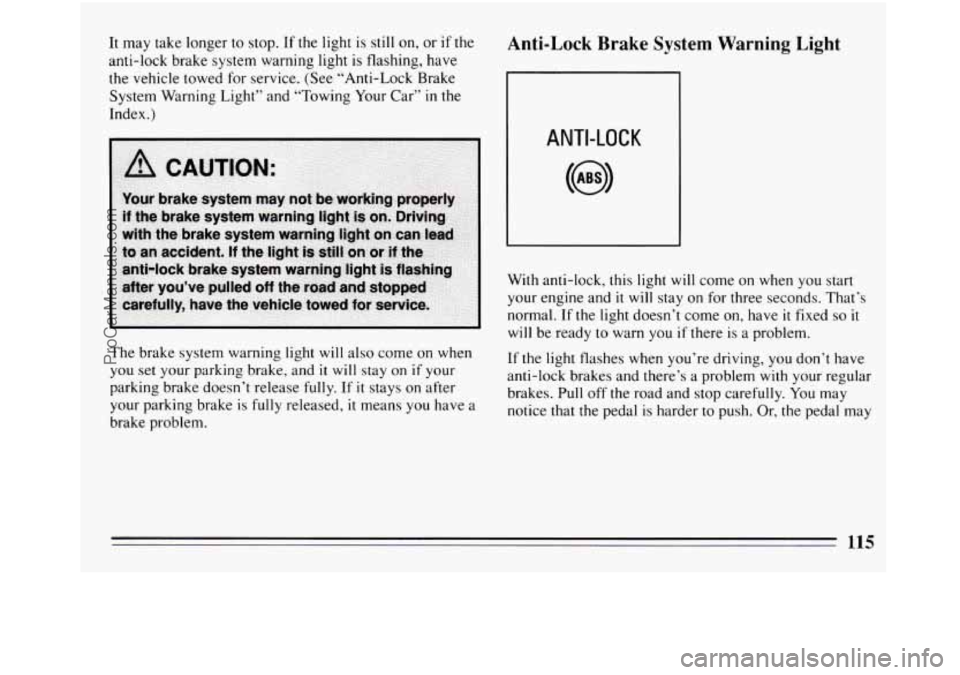
It may take longer to stop. If the light is still on, or if the
anti-lock brake system warning light is flashing, have
the vehicle towed for service. (See “Anti-Lock Brake
System Warning Light” and “Towing Your Car” in the
Index.)
The brake system warning light will also come on when
you
set your parking brake, and it will stay on if your
parking brake doesn’t release
fully. If it stays on after
your parking brake is
fully released, it means you have a
brake problem.
Anti-Lock Brake System Warning Light
ANTI-LOCK
With anti-lock, this light will come on when you start
your engine and
it will stay on for three seconds. That’s
normal. If the light doesn’t come on, have
it fixed so it
will be ready to warn you if there is a problem.
If the light flashes when you’re driving, you don’t have
anti-lock brakes and there’s a problem with your regular
brakes. Pull
off the road and stop carefully. You may
notice that the pedal is harder to push. Or, the pedal may
115
ProCarManuals.com
Page 118 of 308
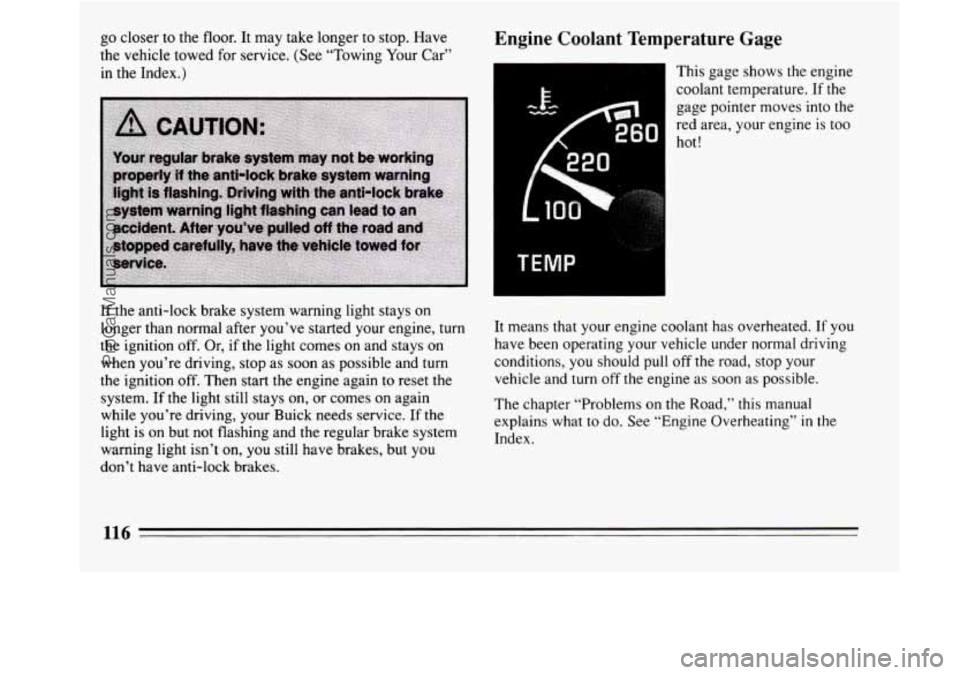
go closer to the floor. It may take longer to stop. Have
the vehicle towed for service. (See “Towing Your Car”
in the Index.) Engine Coolant Temperature Gage
This gage shows the engine
coolant temperature. If the
gage pointer moves into the
red area, your engine
is too
hot!
If the anti-lock brake system warning light stays on
longer than normal after you’ve started your engine, turn
the ignition off. Or,
if the light comes on and stays on
when you’re driving, stop as soon as possible and turn
the ignition off. Then start the engine again to reset the
system. If the light still stays on, or comes on again
while you’re driving, your Buick needs service. If the
light is on but not flashing and the regular brake system
warning light isn’t on,
you still have brakes, but you
don’t have anti-lock brakes. It means
that your engine coolant has overheated. If you
have been operating your vehicle under normal driving
conditions,
you should pull off the road, stop your
vehicle and turn off the engine as soon as possible.
The chapter “Problems on the Road,” this manual
explains what to do. See “Engine Overheating”
in the
Index.
116
ProCarManuals.com
Page 145 of 308
There’s something else about drinking and driving that
many people don’t know. Medical research shows that
alcohol
in a person’s system can make crash injuries
worse. That’s especially true for brain, spinal cord and
heart injuries. That means that if anyone who has been
drinking
-- driver or passenger -- is in a crash, the
chance of being killed or permanently disabled
is higher
than if that person had not been drinking. And we’ve
already seen that the chance of
a crash itself is higher for
drinking drivers.
Control of a Vehicle
You have three systems that make your vehicle go where
you want it to go. They are the brakes, the steering and
the accelerator. All three systems have to do their work
at the places where the tires meet the road.
.... . . ...
Sometimes, as when you’re driving on snow or ice, it’s
easy
to ask more of those control’systems than the tires
and road can provide. That means
you can lose control
of your vehicle.
ProCarManuals.com
Page 146 of 308
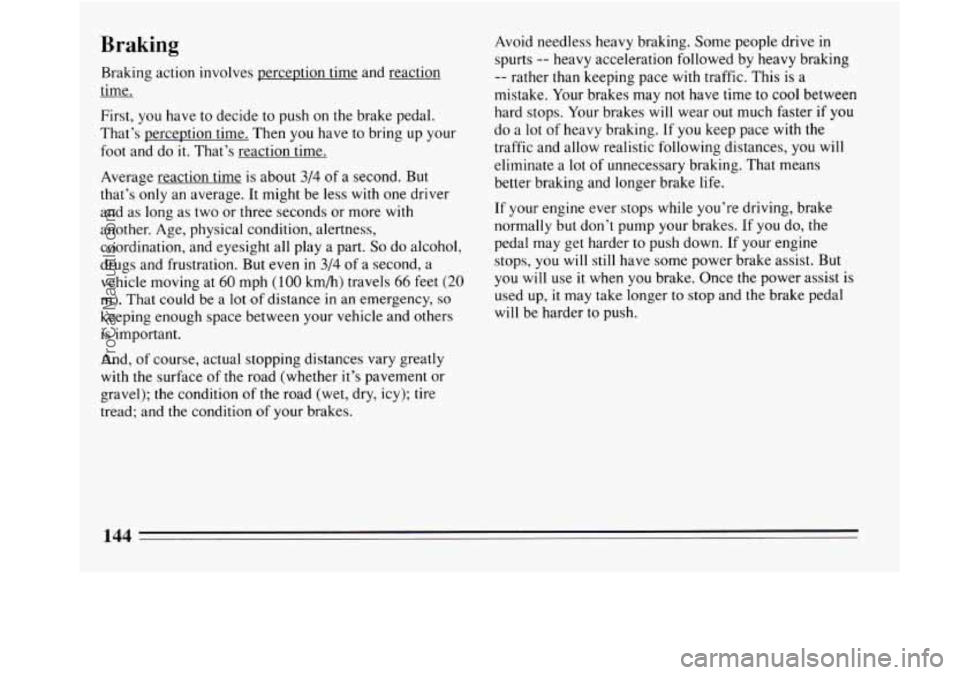
Braking
Braking action involves perception time and reaction
time.
First, you have to decide
to push on the brake pedal.
That’s perception time. Then you have
to bring up your
foot and do it. That’s reaction time.
Average reaction time is about
3/4 of a second. But
that’s only an average. It might be less with one driver
and as long as two or three seconds or more with
another. Age, physical condition, alertness,
coordination, and eyesight all play a part.
So do alcohol,
drugs and frustration. But
even in 3/4 of a second, a
vehicle moving at
60 mph (100 km/h) travels 66 feet (20
m). That could be a lot of distance in an emergency, so
keeping enough space between your vehicle and others
is important.
And, of course, actual stopping distances vary greatly
with the surface
of the road (whether it’s pavement or
gravel); the condition of
the road (wet, dry, icy); tire
tread; and
the condition of your brakes. Avoid
needless heavy braking. Some people drive in
spurts
-- heavy acceleration followed by heavy braking
-- rather than keeping pace with traffic. This is a
mistake. Your brakes may
not have time to cool between
hard stops. Your brakes
will wear out much faster if you
do a lot of heavy braking. If you keep pace with the
traffic and allow realistic following distances, you will
eliminate a lot of unnecessary braking. That means
better braking and longer brake life.
If your engine ever stops while you’re driving, brake
normally but don’t pump your brakes. If you do, the
pedal may get harder to push down. If your engine
stops, you
will still have some power brake assist. But
you
will use it when you brake. Once the power assist is
used up,
it may take longer to stop and the brake pedal
will be harder to push.
144
ProCarManuals.com
Page 147 of 308
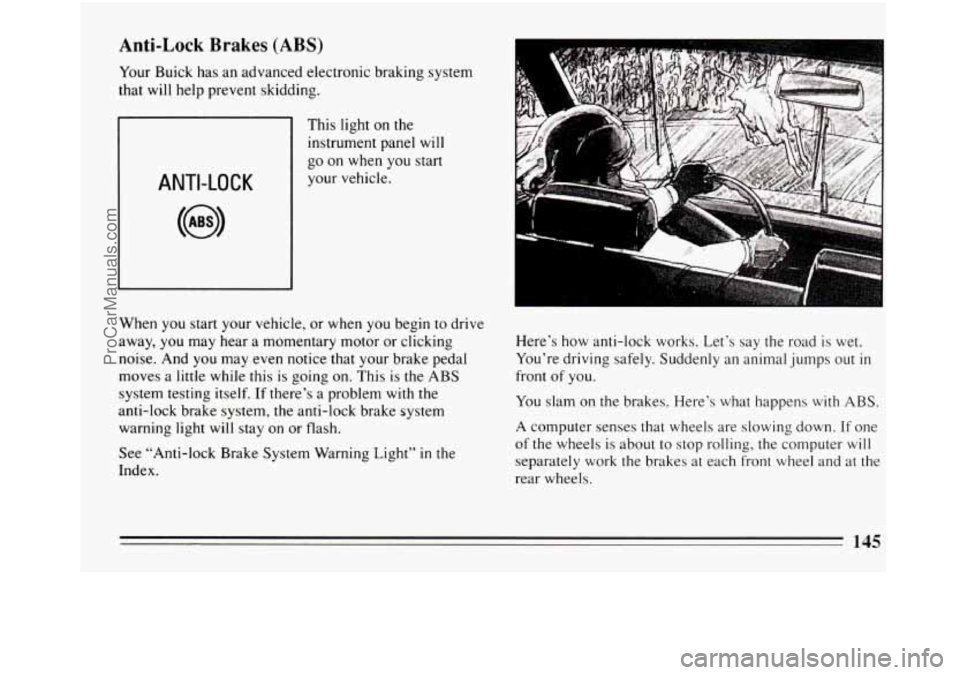
Anti-Lock Brakes (ABS)
Your Buick has an advanced electronic braking system
that will help prevent skidding.
ANTI-LOCK
This light on the
instrument panel will
go on when you start
your vehicle.
When you start your vehicle, or when you begin to drive
away, you may hear a momentary motor or clicking
noise. And
you may even notice that your brake pedal
moves a little while this is going on. This is the
ABS
system testing itself. If there’s a problem with the
anti-lock brake system, the anti-lock brake system
warning light
will stay on or flash.
See “Anti-lock Brake System Warning Light”
in the
Index. Here’s how
anti-lock works. Let’s say the road is wet.
You’re driving safely. Suddenly an animal jumps out
in
front of you.
You slam on the brakes. Here’s what happens
with ABS.
A computer senses that wheels are slowing down. If one
of the wheels
is about to stop rolling, the computer will
separately work the brakes at each front wheel and at the
rear wheels.
145
ProCarManuals.com